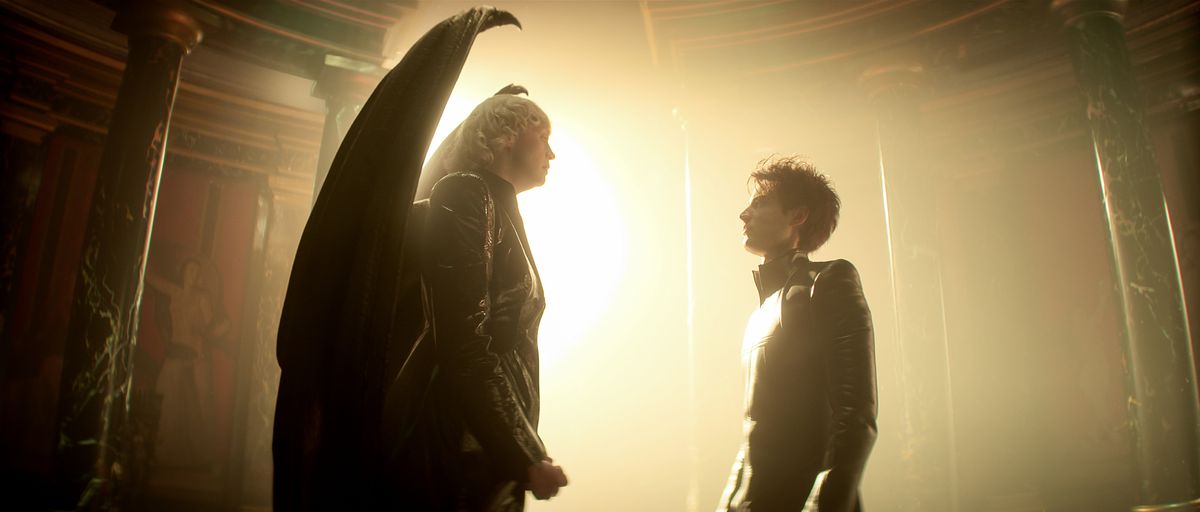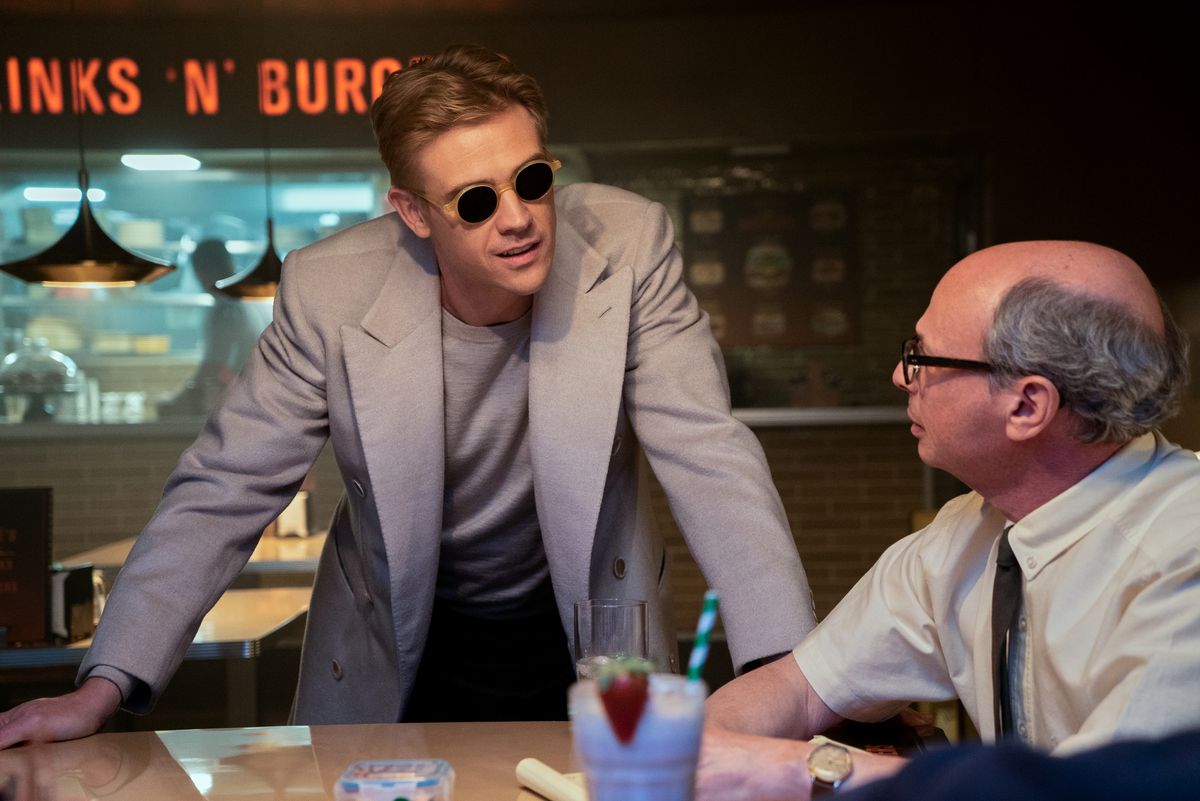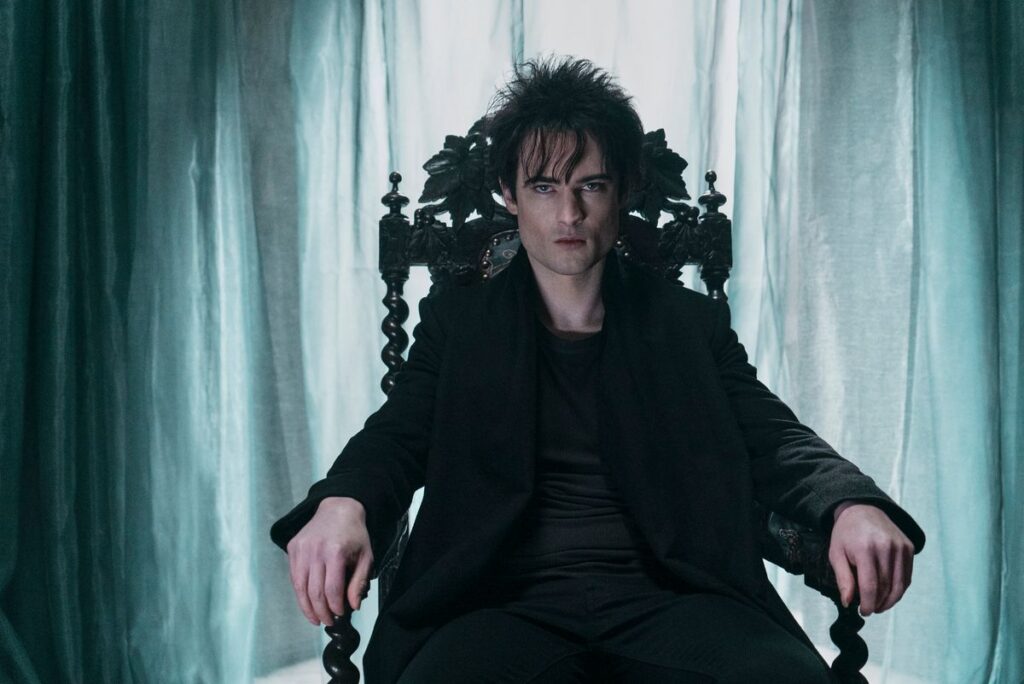Netflix’s fantasy series The Sandman opens with a small chunk of exposition explaining its protagonist Morpheus, the King of Dreams — which is much more than comics readers got when Neil Gaiman’s Sandman series launched in 1988. Even given the series’ small concession to an audience that may need upfront hooks to commit to the show, both the comics version and the Netflix version of the story leave a great deal for the audience to learn over time. And both versions parcel out that information slowly, as it becomes relevant to a story where the scope is constantly shifting from the personal to the cosmic.
Viewers who enjoy the process of discovery, who like the kind of narrative that baits a hook in episode 1 and doesn’t reel it in until episode 10, should just dive into the show without explanation. Eventually, it’ll answer a lot of the questions it raises — though given that the first season of The Sandman only covers the first two graphic novels out of 10 (not counting later series spinoffs and sequels), it may take years for Netflix to cover just the mysteries laid out in the opening season.
For those who find this kind of storytelling frustrating, though — viewers who aren’t familiar with the comics and don’t want to spend the first season asking, “Who are these people, why are they like this, and what are they referencing?” — this handy guide to the Sandman cosmos and its most important concepts and characters could come in handy.
Who is Dream?
Photo: Liam Daniel/Netflix
Sandman’s title character, and more or less its protagonist, is Dream of the Endless, a character who’s also a concept and a fundamental force of the universe. Played by Tom Sturridge in the Netflix adaptation, Dream is an immortal entity who broadly embodies and manages the world of dreams. Dream, also called Morpheus, the Sandman, Oneiros, and many other names by many other races, species, and cultures throughout the Sandman series, has the power to create and modify dreams and nightmares, which are also usually embodied as immortal entities — particularly when they’re in his realm, known as the Dreaming.
Mortals — not just humans, but as the comics series shows, also animals, aliens, and anything else sentient — do sometimes visit the Dreaming when they dream, or they may remain at home and have dreams visit them. It’s Dream’s responsibility to keep the world of dreams in check and in balance. What does that mean? We find out early in the series, when he’s unable to do so for a while and things fall apart.
What are Dream’s powers?
Roughly speaking, he can do anything that falls under his purview, so long as it’s relevant to the narrative. In his own realm, he has complete power over how things appear and how they interact. He can make independent, sapient beings from scratch, change them however he wants, and destroy them at will. He can navigate anyone’s dreams, and take things from them or add things to them. He has broad powers over story itself — and in a story that’s fundamentally about storytelling, that’s pretty powerful.
Who are Dream’s siblings?
Early in the series, Dream’s servant Lucienne (Vivienne Acheampong) asks whether he could seek out his siblings for help in a present crisis, and he cuts her off sharply, saying they have their own realms to see to. (Which is true, but also, Dream is incredibly proud and stubborn, and he doesn’t want to admit he needs help.) The nature and identity of all of those siblings takes quite a while to unfold in the books, but here’s a brief rundown, if you’re curious.
Each of Dream’s siblings — Destiny, Death, Desire, Despair, Delirium, and a sixth we’ll get to in a bit — is an immortal like himself, with power over the fundamental aspects of reality associated with their names. They each have radically different personalities, often matching their realms of influence: Despair is grim and glum, Desire is seductive and greedy. Delirium, who doesn’t turn up in season 1, represents insanity, and she ranges from cheerfully dotty to outright psychopathic. (Comics readers eventually learn she used to be Delight, when the universe was much newer, but they never do find out much about what it means for an Endless to change identities.) Destiny also gets left out of season 1, but in the comics, he’s unbudging and ungiving, the least human of the siblings, because he sees himself not as creating or controlling fate, but just endlessly observing it.
Each of the Endless have their own realms that reflect them, and each of them have broad powers over their name concept, whether that means gaining power from people’s desire or despair, being able to wander through the minds of the insane, or carrying the responsibility of taking the dead on to whatever comes next for them. Different Endless feel differently about their relationship with the beings that fall under their portfolio, with Dream acting more like an impartial god over dreamers, while Death treats the dead like something between old friends and young children needing guidance.
Who is the Prodigal, the seventh Endless?
Gaiman’s version of The Sandman kept this mystery going for a long time, so consider this a spoiler for season 3 or 4 or 5, depending on whether the series continues, and whether it skips Sandman’s many small side stories to focus on Dream’s journey. The Prodigal is eventually revealed to be Destruction, an Endless who abandoned his duties and eventually went on a cheerful walkabout, wandering the universe. As he points out to Dream in the comics, destruction seems to be proceeding just fine without anyone overseeing it, which raises the question of whether the Endless are actually necessary as conscious, active entities — a message that doesn’t go over well with Dream, who’s duty-driven as well as proud.
Destruction’s arc certainly raises questions about how significant the Endless are, and whether they truly have purpose. But the comics series never fully explores those questions, since it’s so focused on Dream, and Dream himself has much more immediate problems than existentialist self-exploration.
Who gave Dream his powers? Who’s his boss?

Image: Netflix
The way the comics depict it, The Endless simply came into being the first time a sentient creature had a destiny, or dreamed, or desired, or died, and so on. Again, Dream and his family are fundamental forces as much as they are people, so they don’t seem to have been created by anyone, and they don’t answer to anyone. They have a great deal of power in their anthropomorphized form, but apart from creating servants and bargaining with mortals and other entities, they aren’t part of anyone else’s hierarchy — which is important in a cosmos this crowded and overpacked with other immortals.
Then why does Dream have magical artifacts of power? Where did he get those?
The Netflix series doesn’t explain this in detail, but essentially, Dream put a lot of his own inherent power into creating tools that more efficiently let him channel and shape the Dreaming. He didn’t get those devices from anyone or anywhere, and when he’s weak after being cut off from his realm and his duties for the majority of a century, he wants them back in order to reabsorb that invested power. But you could also see the whole thing as a symbolic quest to reassert his power and declare his presence to a variety of interested parties.
Is there a God in the Sandman mythos?
There sure is — there are tons of them, in fact. Much like in the increasingly messy Marvel Cinematic Universe canon of gods (which reflects the endlessly messy Marvel Comics canon of gods), the Sandman world is seen to include various pantheons, including the Greco-Roman and Egyptian gods, who have fallen on hard times because mortals largely stopped worshipping them. Heaven and hell are real places in the Sandman mythos. Biblical figures like Cain, Abel, and Eve were real historical figures who eventually became dreams in Dream’s realm. That’s because they’ve passed into myth and legend, and stories are part of his kingdom. Lucifer Morningstar, aka the Devil, is real (and played by Gwendoline Christie), with a significant part to play in season 1, and a much bigger role in a later Sandman arc.
Is the heaven Lucifer was cast out of the Judeo-Christian heaven, with the Judeo-Christian God? That’s very much up to interpretation. There are certainly traditional angels as characters in the Sandman comics series, and they serve and worship a God who’s overtly present and powerful — but whoever that God is, they don’t have a whole lot to do with Dream’s story, and they’re much more an over-there-somewhere idea and ideal than a significant part of this particular narrative.
Who else is a significant power in Sandman?
One of the big principles of the Sandman universe is that essentially, all stories are true and real, to one degree or another — in the Dreaming, if not in reality, and in the mind, if not in mortal history. Sandman was in part a way for Gaiman to create a single narrative linking all of DC Comics’ past stories, which is why the Sandman comic also (very marginally) includes DC superheroes like Batman and Martian Manhunter, alongside revived DC characters like Matthew the Raven (originally a human villain in Alan Moore’s Swamp Thing, though the Netflix series removes that backstory), Cain and Abel (originally Cryptkeeper-style hosts for DC’s 1950s anthology comics House of Mystery and House of Secrets), and the hero Wesley Dodds, the Golden Age Sandman.
Because Sandman is a gigantic pan-mythic crossover narrative, it also includes mythic figures like the Fates (who Dream consults for information about his lost equipment), the muse Calliope, and the legendary hero Orpheus. They share the page with real people like William Shakespeare, Julius Caesar, Robespierre, and “America’s last Emperor,” Joshua Norton.
But in terms of more significant powers, there are quite a few of them, including the gods, the Faerie Court (as seen in Shakespeare’s A Midsummer Night’s Dream, with Titania, Oberon, and Puck), and anthropomorphic representations of Order and Chaos. Again, expect anyone who figures prominently in myth to be welcome in a Sandman story.
Who is the Corinthian?

Photo: Liam Daniel/Netflix
The Corinthian is a rogue nightmare who saw Dream’s disappearance at the beginning of the Sandman story as an opportunity to go enjoy himself in the mortal world. He has a much more significant role in season 1 of Netflix’s The Sandman than he did in the books, where he played out a similar arc, but in a much more minor way. He’s a useful example of the way Morpheus creates dreams and nightmares who are also people, but doesn’t care much about their individual lives or desires; he seems to regard them as artworks of a sort, made for a purpose, and useless outside of that purpose. As we come to see, he has his favorites who he’s more tolerant of. But he also has strict rules for where dreams are allowed to go and what they’re allowed to do, and the Corinthian far exceeds his mandate of being a bad dream. The Corinthian essentially tries to become a power in his own right, which Morpheus isn’t willing to tolerate from his creations. Morpheus isn’t exactly sentimental or protective about humanity or other sentient life, but he takes his responsibilities seriously, which means keeping the dreams he makes focused on their intended purposes.
Doesn’t that make Dream kind of a jerk, though?
It sure does. One of the fascinating things about Sandman is that Dream often isn’t a particularly sympathetic protagonist. He can be maudlin and mopey, vain and stuffy, remote and superior, or just indifferent to other people’s suffering. His motives are sometimes hard to discern because he’s so inhuman. That’s by design: He is, after all, the manifestation of the idea of stories as much as he’s a person. It’s OK to dislike him when he’s being huffy or bossy.
Just remember that we aren’t exactly seeing him at his best in Sandman season 1 — he’s just off a long, frustrating trauma, during which he was as helpless as he’s ever been in his existence. Dreams like Lucienne, Matthew, Cain, and Abel aren’t his peers, they’re his subjects and creations, so he can’t confide in them. The only beings really on his level are his family, and they’re a problematic bunch at best. So he doesn’t really have anyone to talk to about being off his stride and having to figure out who he is after what he went through.
What else do I need to know?
Neil Gaiman’s original Sandman arc eventually resolved with plenty of open questions about the nature of this universe, and we can expect the TV series will as well. Don’t expect to have all the answers, understand that that’s part of the experience, and realize that most of these characters aren’t people so much as concepts and purposes made flesh, and it’ll all fall together a lot more easily. You’re in the realm of the mythic when you’re reading or watching Sandman, and most myths are more about capturing a feeling or illustrating a principle than about making sure every last plot point adds up. Enjoy the ride.

